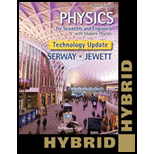
Concept explainers
(a)
The ratio of the wavelength of the photon to the wavelength of the electron.
(a)
Answer to Problem 47P
The ratio of the wavelength of the photon to the wavelength of the electron is
Explanation of Solution
It is given that the speed of the electron is close to the
Write the equation for the kinetic energy of the electron.
Here,
Write the equation for the de Broglie wavelength of the electron.
Here,
Write the equation for the momentum of the electron.
Here,
It is given that energy of the photon is equal to the kinetic energy of the electron.
Write the relationship between the energy of the photon and the kinetic energy of the electron.
Here,
Write the equation for the energy of the photon in terms of its frequency.
Here,
Write the equation for the wavelength of the photon.
Here,
Multiply the numerator and denominator of the right hand side of the above equation by
Replace denominator of the right hand side of the above equation by equation (V).
Put equation (IV) in the above equation.
Put equation (I) in the above equation.
Conclusion:
Take the ratio of equation (VI) to equation (III).
Therefore, the ratio of the wavelength of the photon to the wavelength of the electron is
(b)
The value of the ratio of the wavelength of the photon to the wavelength of the electron for the particle speed
(b)
Answer to Problem 47P
The value of the ratio of the wavelength of the photon to the wavelength of the electron for the particle speed
Explanation of Solution
Write the expression for the Lorentz factor.
Put the above equation in equation (VII).
Conclusion:
Substitute
Therefore, the value of the ratio of the wavelength of the photon to the wavelength of the electron for the particle speed
(c)
The change in answer of part (b) if the particle were a proton instead of electron.
(c)
Answer to Problem 47P
There will be no change in the answer to part (b) since the ration does not depend on mass.
Explanation of Solution
The expression for the ration of the wavelength of the photon to the wavelength of the material particle is given by equation (VIII). The equation contains only the speed of the material particle and the speed of light in vacuum. The equation is independent of the mass of the particle.
Since the ratio is independent of the mass of the material particle, the value of the ratio will be the same if the electron is replaced with a proton of same speed. This implies there will be no change in the answer to part (b) even when the electron is replaced with a proton.
Conclusion:
Thus, there will be no change in the answer to part (b) since the ration does not depend on mass.
(d)
The value of the ratio of the wavelength of the photon to the wavelength of the electron for the particle speed
(d)
Answer to Problem 47P
The value of the ratio of the wavelength of the photon to the wavelength of the electron for the particle speed
Explanation of Solution
Equation (VIII) can be used to find the value of the ratio.
Conclusion:
Substitute
Therefore, the value of the ratio of the wavelength of the photon to the wavelength of the electron for the particle speed
(e)
The value the ratio of the wavelengths approaches at high particle speeds.
(e)
Answer to Problem 47P
The value the ratio of the wavelengths approaches at high particle speeds is
Explanation of Solution
At high particles speeds,
Substitute this in the expression for Lorentz factor.
As
Conclusion:
Replace
Therefore, the value the ratio of the wavelengths approaches at high particle speeds is
(f)
The value the ratio of the wavelengths approaches at low particle speeds.
(f)
Answer to Problem 47P
The value the ratio of the wavelengths approaches at low particle speeds is
Explanation of Solution
At low particles speeds,
As
Also,
Conclusion:
Put approximations (IX) and (X) in equation (VII) to find the value of the ratio at low particle speeds.
For low values of
Replace
Therefore, the value the ratio of the wavelengths approaches at low particle speeds is
Want to see more full solutions like this?
Chapter 40 Solutions
Physics for Scientists and Engineers with Modern, Revised Hybrid (with Enhanced WebAssign Printed Access Card for Physics, Multi-Term Courses)
- An object is placed 24.1 cm to the left of a diverging lens (f = -6.51 cm). A concave mirror (f= 14.8 cm) is placed 30.2 cm to the right of the lens to form an image of the first image formed by the lens. Find the final image distance, measured relative to the mirror. (b) Is the final image real or virtual? (c) Is the final image upright or inverted with respect to the original object?arrow_forwardConcept Simulation 26.4 provides the option of exploring the ray diagram that applies to this problem. The distance between an object and its image formed by a diverging lens is 5.90 cm. The focal length of the lens is -2.60 cm. Find (a) the image distance and (b) the object distance.arrow_forwardPls help ASAParrow_forward
 Physics for Scientists and Engineers: Foundations...PhysicsISBN:9781133939146Author:Katz, Debora M.Publisher:Cengage Learning
Physics for Scientists and Engineers: Foundations...PhysicsISBN:9781133939146Author:Katz, Debora M.Publisher:Cengage Learning Principles of Physics: A Calculus-Based TextPhysicsISBN:9781133104261Author:Raymond A. Serway, John W. JewettPublisher:Cengage Learning
Principles of Physics: A Calculus-Based TextPhysicsISBN:9781133104261Author:Raymond A. Serway, John W. JewettPublisher:Cengage Learning Modern PhysicsPhysicsISBN:9781111794378Author:Raymond A. Serway, Clement J. Moses, Curt A. MoyerPublisher:Cengage Learning
Modern PhysicsPhysicsISBN:9781111794378Author:Raymond A. Serway, Clement J. Moses, Curt A. MoyerPublisher:Cengage Learning College PhysicsPhysicsISBN:9781938168000Author:Paul Peter Urone, Roger HinrichsPublisher:OpenStax College
College PhysicsPhysicsISBN:9781938168000Author:Paul Peter Urone, Roger HinrichsPublisher:OpenStax College Physics for Scientists and Engineers with Modern ...PhysicsISBN:9781337553292Author:Raymond A. Serway, John W. JewettPublisher:Cengage Learning
Physics for Scientists and Engineers with Modern ...PhysicsISBN:9781337553292Author:Raymond A. Serway, John W. JewettPublisher:Cengage Learning Glencoe Physics: Principles and Problems, Student...PhysicsISBN:9780078807213Author:Paul W. ZitzewitzPublisher:Glencoe/McGraw-Hill
Glencoe Physics: Principles and Problems, Student...PhysicsISBN:9780078807213Author:Paul W. ZitzewitzPublisher:Glencoe/McGraw-Hill





